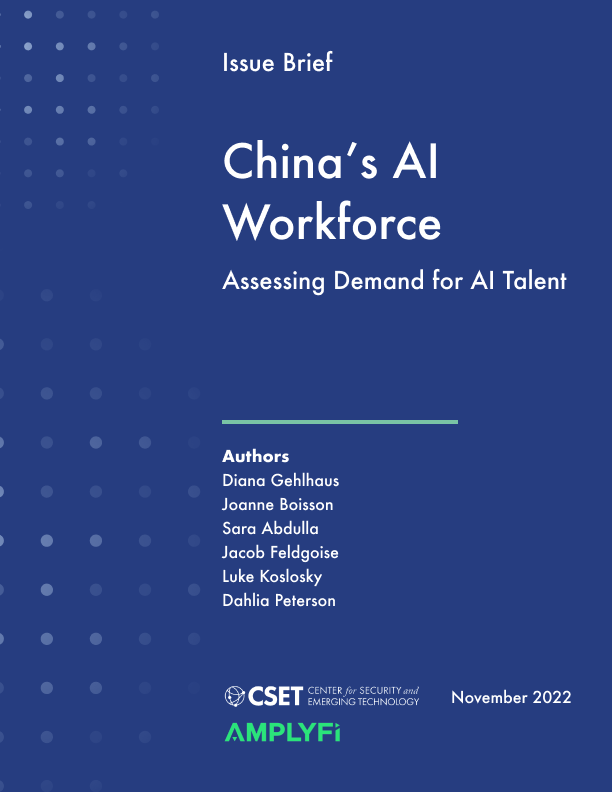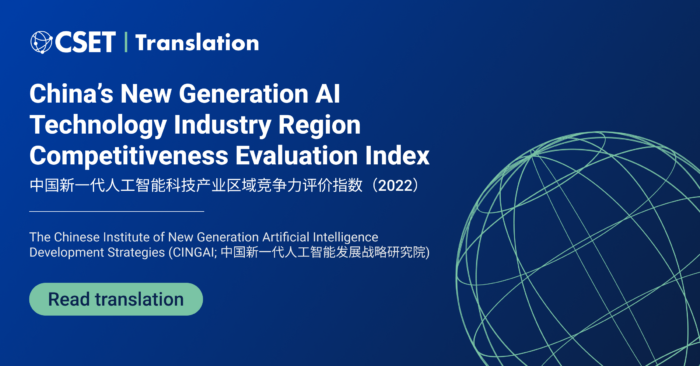U.S. policies on artificial intelligence education and the AI workforce must grow, cultivate, attract, and retain the world’s best and brightest. Given China’s role as a producer of AI talent, understanding its AI workforce could provide important insight. This report provides an analysis of the AI workforce demand in China using a novel dataset of 6.8 million job postings. It then outlines potential implications along with future reports in this series.
While a better understanding of China’s AI workforce would be valuable, surprisingly little data is available. To date, most current knowledge stems from sporadic Chinese ministry, university, and company reports, or from news media outlets. A review of these reports suggests China is heavily investing in AI education and workforce development, in addition to recruiting native AI talent working abroad. But are these policies and investments producing the desired AI workforce?
To bridge the Chinese AI workforce data gap, we provide an analysis of the state of AI workforce demand in China. We assess AI workforce demand using job postings data, widely used in labor economics for this purpose. We do this using a novel sample of 6.8 million unique job postings in China, built in partnership with AMPLYFI, a UKbased machine learning company. The AMPLYFI team classified these postings as AI or non-AI related, using the same two technical and two non-technical occupational categories as defined in previous CSET research on the U.S. AI workforce.
We find that a sizable share—more than 30 percent—of the 6.8 million job postings analyzed could be considered AI or AI-related. Of these, 14 percent, or 955,000, are part of the technical AI workforce, defined here in two teams (Technical Teams 1 and 2) as talent that could be involved in the design, development, and deployment of AI.1 The majority of technical AI job postings—about 53 percent—require a bachelor’s degree, while most non-technical AI positions do not. Moreover, about 60 percent of technical postings are located in Guangdong Province, Shanghai Municipality, and Jiangsu Province, likely due to their economic importance as locations for major Chinese AI companies and universities. The wide range of median salaries across Chinese cities and provinces further points to areas where AI-related technical talent commands relatively high earnings, such as Shanghai and Beijing.
The majority of AI-related positions were also junior in terms of desired experience; this suggests three things. First, other informal avenues outside of traditional job boards, such as social networks, university partnerships, and internal referrals, may be more often used to recruit more skilled or experienced hires. Second, given that many technical positions require at least a college degree, and given the rising number of college graduates, it suggests four-year degrees could be a gatekeeper market signal for technical positions similar to the United States. Finally, among the AI-related job postings CSET reviewed, many called for “fresh graduates.” This could be a reference to the pervasiveness of the expected “9-9-6” (nine to nine, six days a week) work culture in China’s tech community.
Moreover, we find a sizable share of technical job postings are for roles that are actually involved in AI. Scanning both technical teams’ job postings using a list of AI keywords, we find that 10 percent, or 36,000, of Technical Team 1 postings (e.g., most computer and mathematical science occupations) were specific to AI, with “machine learning” and “robotics” as leading keywords. A larger share of postings containing an AI keyword also required graduate degrees; 17 percent of Technical Team 1 postings with an AI keyword did, compared 4 percent of all Technical Team 1 postings. A review of about 100 postings requiring a PhD showed a wide range of AI applications being recruited for including robotics, image recognition, blockchain, bioinformatics, autonomous vehicles, and smart cities.
Overall, our findings highlight the complexity of China’s AI ecosystem and the need to better understand the state of China’s AI workforce. Investing in more data on China’s AI workforce could assist the United States in its own national AI strategic planning, particularly in developing targeted U.S. national security, education, and workforce policies.
This paper is the first in a series on AI workforce demand in China. It provides the foundation for future reports by detailing the dataset, methodology, and descriptive statistics for key fields of interest, such as desired education, experience, and salary. Future work will analyze these job postings in greater detail by providing insights into the geographic distribution of jobs, AI applications for which companies are hiring, skills and fields of study associated with AI job postings, and details of the companies hiring these workers. We hope this series will provide a holistic assessment of the nature of China’s AI workforce from a demand-side perspective.
Full Report

 cset.georgetown.edu
cset.georgetown.edu
Executive Summary
For the United States to build a globally competitive artificial intelligence (AI) workforce, U.S. AI education and workforce policies must grow, cultivate, attract, and retain the world’s best and brightest. The AI workforce is global and in high demand, and a large share of top-tier technical talent in the United States is foreign-born. Given China is a major producer of AI-skilled talent, understanding its AI workforce could provide U.S. policymakers with important insight.While a better understanding of China’s AI workforce would be valuable, surprisingly little data is available. To date, most current knowledge stems from sporadic Chinese ministry, university, and company reports, or from news media outlets. A review of these reports suggests China is heavily investing in AI education and workforce development, in addition to recruiting native AI talent working abroad. But are these policies and investments producing the desired AI workforce?
To bridge the Chinese AI workforce data gap, we provide an analysis of the state of AI workforce demand in China. We assess AI workforce demand using job postings data, widely used in labor economics for this purpose. We do this using a novel sample of 6.8 million unique job postings in China, built in partnership with AMPLYFI, a UKbased machine learning company. The AMPLYFI team classified these postings as AI or non-AI related, using the same two technical and two non-technical occupational categories as defined in previous CSET research on the U.S. AI workforce.
We find that a sizable share—more than 30 percent—of the 6.8 million job postings analyzed could be considered AI or AI-related. Of these, 14 percent, or 955,000, are part of the technical AI workforce, defined here in two teams (Technical Teams 1 and 2) as talent that could be involved in the design, development, and deployment of AI.1 The majority of technical AI job postings—about 53 percent—require a bachelor’s degree, while most non-technical AI positions do not. Moreover, about 60 percent of technical postings are located in Guangdong Province, Shanghai Municipality, and Jiangsu Province, likely due to their economic importance as locations for major Chinese AI companies and universities. The wide range of median salaries across Chinese cities and provinces further points to areas where AI-related technical talent commands relatively high earnings, such as Shanghai and Beijing.
The majority of AI-related positions were also junior in terms of desired experience; this suggests three things. First, other informal avenues outside of traditional job boards, such as social networks, university partnerships, and internal referrals, may be more often used to recruit more skilled or experienced hires. Second, given that many technical positions require at least a college degree, and given the rising number of college graduates, it suggests four-year degrees could be a gatekeeper market signal for technical positions similar to the United States. Finally, among the AI-related job postings CSET reviewed, many called for “fresh graduates.” This could be a reference to the pervasiveness of the expected “9-9-6” (nine to nine, six days a week) work culture in China’s tech community.
Moreover, we find a sizable share of technical job postings are for roles that are actually involved in AI. Scanning both technical teams’ job postings using a list of AI keywords, we find that 10 percent, or 36,000, of Technical Team 1 postings (e.g., most computer and mathematical science occupations) were specific to AI, with “machine learning” and “robotics” as leading keywords. A larger share of postings containing an AI keyword also required graduate degrees; 17 percent of Technical Team 1 postings with an AI keyword did, compared 4 percent of all Technical Team 1 postings. A review of about 100 postings requiring a PhD showed a wide range of AI applications being recruited for including robotics, image recognition, blockchain, bioinformatics, autonomous vehicles, and smart cities.
Overall, our findings highlight the complexity of China’s AI ecosystem and the need to better understand the state of China’s AI workforce. Investing in more data on China’s AI workforce could assist the United States in its own national AI strategic planning, particularly in developing targeted U.S. national security, education, and workforce policies.
This paper is the first in a series on AI workforce demand in China. It provides the foundation for future reports by detailing the dataset, methodology, and descriptive statistics for key fields of interest, such as desired education, experience, and salary. Future work will analyze these job postings in greater detail by providing insights into the geographic distribution of jobs, AI applications for which companies are hiring, skills and fields of study associated with AI job postings, and details of the companies hiring these workers. We hope this series will provide a holistic assessment of the nature of China’s AI workforce from a demand-side perspective.
Full Report

China’s AI Workforce - Center for Security and Emerging Technology
U.S. policies on artificial intelligence education and the AI workforce must grow, cultivate, attract, and retain the world’s best and brightest. Given China’s role as a producer of AI talent, understanding its AI workforce could provide important insight. This report provides an analysis of the...


